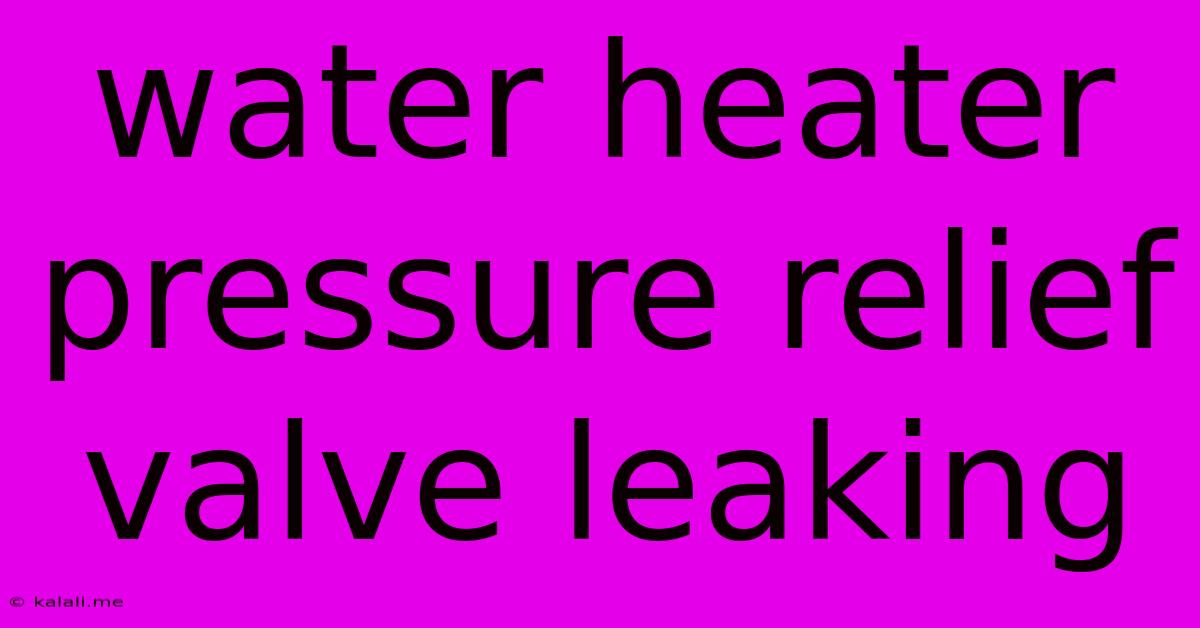Water Heater Pressure Relief Valve Leaking
Kalali
May 21, 2025 · 4 min read

Table of Contents
Water Heater Pressure Relief Valve Leaking: Causes, Solutions, and Prevention
A leaking water heater pressure relief valve is a common household plumbing problem that shouldn't be ignored. This article will cover the reasons why your valve might be leaking, how to troubleshoot the issue, and preventative measures to avoid future problems. Ignoring a leaking valve can lead to serious damage and potential injury, so understanding the problem is crucial for homeowners.
Understanding Your Water Heater Pressure Relief Valve
The pressure relief valve (PRV) is a crucial safety device on your water heater. Its job is to release excess pressure and prevent potentially dangerous explosions. This excess pressure can build up from several factors, including overheating, sediment buildup, and external water pressure fluctuations. When the pressure surpasses a certain threshold (typically around 150 PSI), the valve automatically opens, releasing hot water to relieve the pressure. A small drip or seep is sometimes normal, but a steady stream or significant leak indicates a problem.
Common Causes of a Leaking Water Heater Pressure Relief Valve
Several factors can contribute to a malfunctioning and leaking pressure relief valve. Let's delve into the most common culprits:
-
Excess Pressure: This is the most frequent reason. A faulty pressure regulator, increased water pressure from the main line, or a buildup of sediment within the tank can all lead to excessive pressure. This forces the valve to open more frequently and eventually lead to leaks or premature wear.
-
Valve Failure: Over time, the valve's internal components can wear out or become corroded, especially with hard water. Mineral deposits can clog the valve's internal mechanism, hindering its ability to seal properly. This can lead to a constant drip or leak even under normal pressure.
-
Temperature and Thermal Expansion: As water heats up, it expands. If your water heater is overheating due to a faulty thermostat or heating element, the resulting expansion can exceed the valve's pressure threshold, causing it to leak.
-
Sediment Buildup: Mineral deposits and sediment build up in your water heater tank over time. This can restrict water flow and increase pressure, putting extra stress on the pressure relief valve.
Troubleshooting and Repairing a Leaking Pressure Relief Valve
Before attempting any repairs, always turn off the power to the water heater (electric) or shut off the gas supply (gas). Allow the water heater to cool completely.
1. Check for Excess Pressure: Use a pressure gauge to measure the water pressure in your tank. If it's significantly higher than the recommended level (usually around 30-50 PSI), you need to address the underlying pressure issue. This often involves adjusting the pressure regulator on your main water line (best left to a professional).
2. Inspect the Valve for Debris: Carefully inspect the valve's discharge pipe for any visible obstructions or mineral deposits. A simple cleaning may resolve the issue. You can try gently flushing the valve by opening it briefly to see if any debris is expelled.
3. Test the Valve: With the power/gas off and the tank cooled, manually lift the pressure relief valve lever. If a significant amount of water flows out, the valve is likely functioning correctly and the issue lies elsewhere (e.g., excessive pressure). If only a small amount of water releases, and the leak is still present, the valve itself may be faulty.
4. Replace the Valve: If you've ruled out other causes, and the valve continues to leak, it's likely time for a replacement. This is a relatively straightforward plumbing repair, but if you're not comfortable working with plumbing, it's best to call a qualified plumber. Always ensure you replace it with a valve rated for the same pressure and temperature as your existing one.
Preventing Future Leaks
Prevention is key to avoiding future pressure relief valve problems:
-
Regular Maintenance: Flush your water heater annually to remove sediment buildup.
-
Pressure Gauge Monitoring: Periodically check your water pressure using a gauge.
-
Professional Inspection: Have a qualified plumber inspect your water heater periodically to identify potential issues before they become major problems.
By understanding the potential causes, performing regular maintenance, and knowing when to call a professional, you can keep your water heater safe and functioning efficiently for years to come. Remember, a leaking pressure relief valve is a safety hazard that shouldn't be overlooked.
Latest Posts
Latest Posts
-
How Can We Increase The Strength Of Electromagnet
May 21, 2025
-
Running Two Days In A Row
May 21, 2025
-
Can I Use Tile Grout As Adhesive
May 21, 2025
-
Can You Bring Coffee On A Plane
May 21, 2025
-
Can A Rabbi Marry A Non Jewish Woman
May 21, 2025
Related Post
Thank you for visiting our website which covers about Water Heater Pressure Relief Valve Leaking . We hope the information provided has been useful to you. Feel free to contact us if you have any questions or need further assistance. See you next time and don't miss to bookmark.